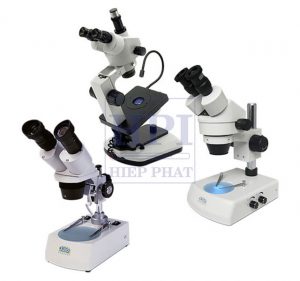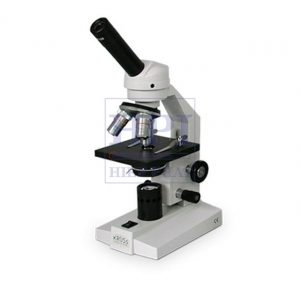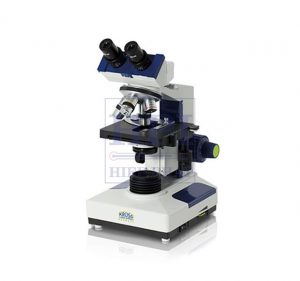The microscope is a fairly common laboratory instrument. In this article, let’s join Hiep Phat to learn more about what a microscope is, its classification as well as its application in experiments and in production.
1. What is a microscope?

Microscope is a very popular instrument in laboratories, often used in laboratories. used in the field of chemistry, biology, physics or in archaeological studies.
This special glass can magnify extremely small objects into more detail and clarity (magnification up from 40 – 3000 times). The device helps users to observe very small objects in space that cannot be seen by the human eye.
The image of the object will be magnified through multiple lenses, the image is displayed in a simulation perpendicular to the axis of the lens. This technique is called microscopy, the English name is microscopy.
2. Structure of a microscope

Depending on the type of glass, they have different functions and structures. However, in general, all types of microscopes have some common structure including 4 systems: bracket, magnification system, lighting system, adjustment system.
– Bracket includes components: base, body, telescope bearing, specimen table and clip template.
– Magnification system includes parts:
+ Eyepiece: is a converging lens with a very short focal length used to produce a real image of the object to be observed. This is the part for the observer to put his eyes in and look at the glasses, they have 2 types of double and single tubes.
+ Objective: This is also an important and indispensable part of the microscope. There are 3 magnifications: x10, x40, x100.
– The lighting system includes the following components:
+ Light source
+ Condenser inner curtain to adjust the amount of light passing through the condenser
+ Condenser is used to focus light rays and measure light onto the specimen to be observed
+ Move condenser up and down to adjust brightness
– The adjustment system includes:
+ Macro snail
+ Micro-level screws
+ Up and down adjustment screw
+ Brightness adjustment screw
+ Curtain adjustment knob
+ Snail to move the slide with the template
3. How to use, note when using
How to use
Depending on the structure of each machine, the usage is different, but basically, there are still some operations using the microscope you need. Note:
– Place the template on the table and then use clamps to hold the template
– Then, add 1 drop of lubricating oil to submerge on x100 objective microscope
– Depending on the template, you can choose the appropriate objective type
– Adjust image light accordingly
– Adjust the condenser for the x10 objective to the bottom, the x40 objective to be in the middle, the x100 objective to be at the condenser. first paragraph
– Adjust the screen size corresponding to the objective
– Then lower the objective close to the template
– Eyes look at the eyepiece and turn the macroscrew to bring the objective up until a blurred image of the field is visible and then make adjustments Micro-level screws to see the clearest image.
Note when using microscope
– Put the device in a dry place, when not in use, you should put the glasses in a box with a silicagel desiccant package to prevent mold from forming. .
– Clean the holder daily with a clean cloth and wipe the oil objective with a special soft paper soaked in xylene or alcohol.
– Finally clean the lighting system periodically for the best lighting.
4. Common types of microscopes
Classify by function
Accordingly, there are 3 main types of microscope commonly used which are: electronic, biological, stereoscopic . Each type will have its own characteristics, meeting specific jobs.
Electronic microscope: is a type of glass Using a magnetic lens to focus the electron beam, the electron beam is accelerated under voltages ranging from a few tens of kV to several hundred kV. The whole system is placed in a high vacuum chamber. Usually, this type of glass has a resolution that far exceeds that of other traditional optical microscopes.
Biological microscope: With magnification Large capacity with the ability to connect to computers and support users to record data, share data, … Biological microscope is really an essential device for research, analysis, and finding. understand microscopic patterns.
Stereoscopic microscope: normally used to observe the surface image of the object sample at low magnification. This microscope uses a beam of white light that hits the surface of the object and results in a 3-D image of the specimen.

Refer to the Kruss stereo microscope line MSL4000 Series
Classify by structure
Monocular, binocular, 3-eye, handheld, … This is the classification by structure.
Monocular microscope: This is a microscope Microscopy has the feature that when observing a specimen you have to squint one eye. This product is constructed with an elongated optical lens, allowing the user to have the most optimal specimen observation.

Refer to the Kruss monocular microscope MML1000 Series
Binocular microscope: This product quite popular and present in all lines such as electronic, biological, stereoscopic glasses. One of the famous brands of binocular microscopes is Optika microscope, Olympus, … This type of product is widely used in laboratories, research, educational institutions, repair, …

Refer to Kruss binocular microscope line MBL2000 Series
Triscope: This line of glasses allowing users to add more light or connect a camera for the easiest viewing.
Hand-held microscope: With advantages The main feature of this line of electron microscopes is light weight, convenient in observation. Simple to use, just point the lens to the specimen and the image is transmitted to the projection screen or computer for optimal viewing.
5. Where to buy microscope?
Hiep Phat Equipment Co., Ltd is a unit specializing in importing and distributing Microscope products from the manufacturer. Export Kruss – Germany. The product lines at Hiep Phat are always guaranteed to be genuine, reputable, suitable for the needs of customers.
Besides, with a team of experienced and qualified staff, Hiep Phat is always ready to help customers if they encounter any problems. any problems during the use of the product. Hiep Phat will also support delivery, user manual and have warranty and maintenance policies suitable for customers who buy our products.
Hopefully this article has helped you better understand what a microscope is and how to use this specialized equipment properly. If you are looking to buy microscope, or have any questions during the use of lab equipment, do not hesitate to contact Hiep Phat qua Hotline: (028) 6287 4765 or Email: sales@thietbihiephat.com to receive timely advice.
Microscope

Leave your questions, we will answer them right away



 EN
EN VN
VN




